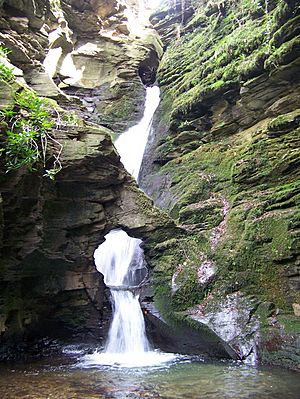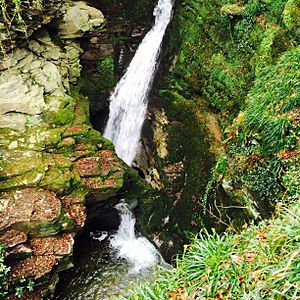St Nectan's Kieve facts for kids
Saint Nectan's Kieve (which means Nathan's tub in Cornish) is a special place in St Nectan's Glen, near Tintagel in Cornwall, Great Britain. It's a deep pool of water, called a plunge pool, that's filled by a waterfall about 18 meters (60 feet) high. This waterfall is part of the Trevillet River.
Contents
What is Saint Nectan's Kieve?
Saint Nectan's Kieve is a natural basin formed by a powerful waterfall. The word "kieve" comes from the Cornish word Cuva, which means "tub" or "basin." The waterfall drops into this deep pool, and then the water flows out through a natural rock arch. After that, it falls another 3 meters (10 feet) into a wide, shallow pool.
How Was the Kieve Formed?
The Trevillet River has carved its way through ancient rock called Late Devonian slate. If you look closely at the rock walls around the waterfall, you can see signs of older kieves that were formed higher up over many, many years. The main pool you see today is thought to be about 3.6 meters (12 feet) deep.
Where Did the Name "Saint Nectan's Kieve" Come From?
You might think the name comes from a saint named Nectan, but that's actually a story that became popular much later! The name was first written down in 1799 as Nathan's Cave. It was named after a local person, either Nathan Williams or Nathan Cock. The Cornish word Cuva (pronounced keeva) means "tub," which describes the pool perfectly.
The Legend of Saint Nectan
There's a popular legend that a saint named Nectan lived in a hermitage (a quiet place for a religious person) above the waterfall in the 6th century. The story says he would ring a silver bell during storms to warn ships about dangerous rocks near the coast. However, there's no real proof that Saint Nectan ever lived here. His actual home was much further north, in a place called Hartland, Devon.
Who Created the Saint Nectan Legend?
The idea of Saint Nectan being connected to the falls was mostly created by a clergyman named Reverend Robert Stephen Hawker in the 1800s. He wrote a poem in 1846 called The Sisters of the Glen where he first linked the falls to the saint. The "hermitage" he wrote about was actually just a simple summerhouse, not a saint's home. Many of the stories and legends about the site came from Hawker's poems and the lively imagination of a local farmer named William Goard, who used to give tours of the falls.
Why Do People Think It's a Sacred Place?
Many visitors believe Saint Nectan's Kieve is a special or sacred place, like a cloutie well (a place where people leave offerings). You'll often see colorful ribbons, shiny crystals, photographs, and other small gifts left on the plants and rocks near the waterfall. Some visitors also make small piles of flat stones they find in the stream. These actions show respect and a connection to the place.
Saint Nectan's Kieve in Literature
The waterfall has even inspired writers! A poet named Letitia Elizabeth Landon wrote a poem called St. Knighton’s Kieve. Her poem is based on a legend she heard about hidden treasure at the bottom of the falls. In her poem, she describes a magical golden cup that is impossible to get back.
The Hermitage Building
At the very top of the waterfall, there's a building that some people thought was Saint Nectan's cell. However, it's most likely an 18th-century summerhouse. The stories linking it to a saint came from the imaginations of R. S. Hawker and William Goard. The current owners of the site say that the lower parts of the cottage walls were once part of a chapel built in the 1860s, which was later made bigger around 1900.
Today, you can visit tea gardens in the Hermitage grounds from April to October. A new woodland walkway, opened in 2016, lets visitors see the beautiful falls from above. Before this path, you had to climb the rocks to get these views!



